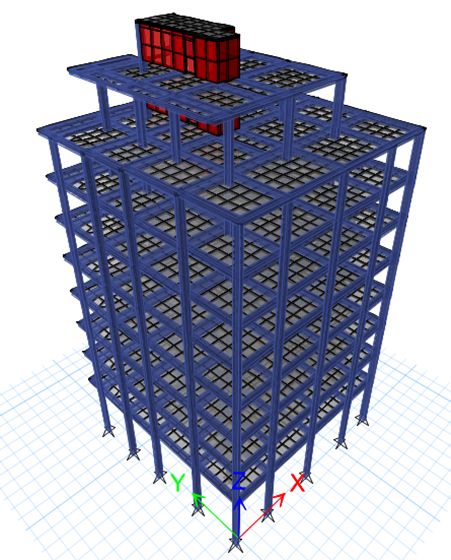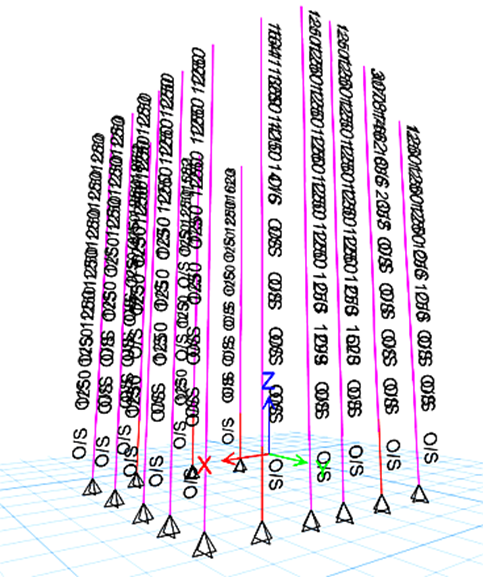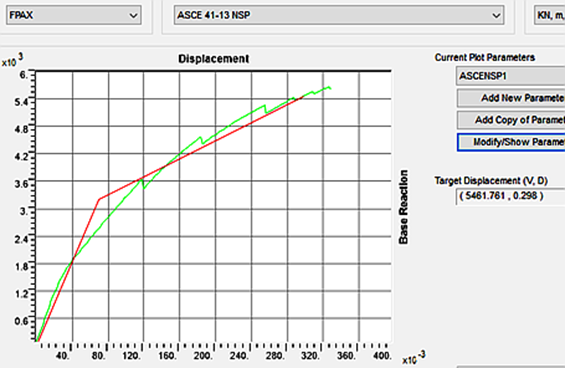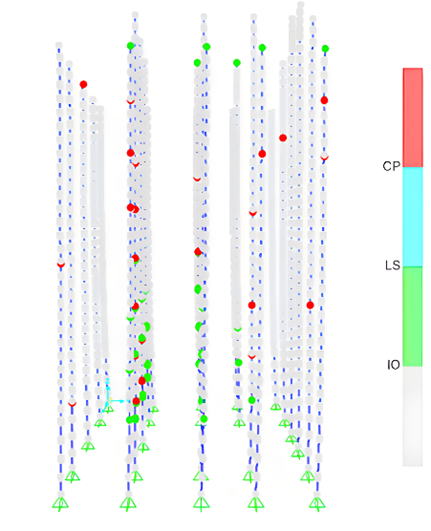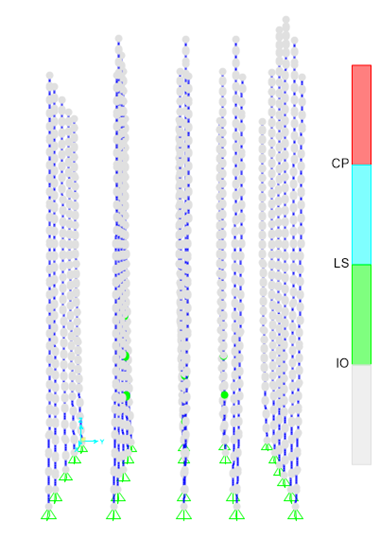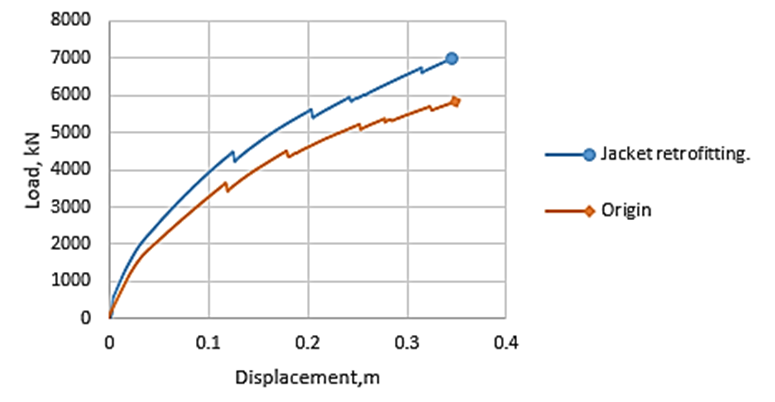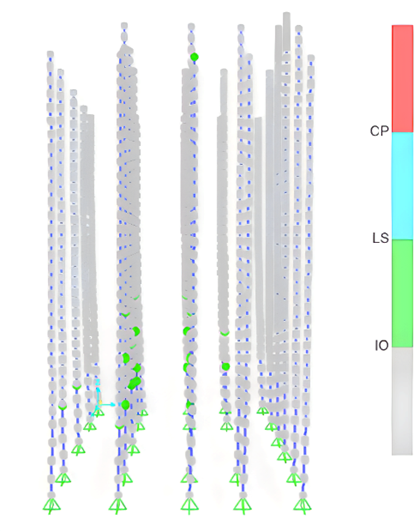Original Scientific Paper, Volume 23, Number 2, Year 2025, No 1265, pp 198-207
Received: Aug 03, 2024 Accepted: Nov 29, 2024 Published: Jun 16, 2025
DOI: 10.5937/jaes0-52568
SEISMIC ASSESSMENT AND RETROFITTING OF RC BUILDING USING CONCRETE JACKETING AND CFRP (A FINITE ELEMENT MODELLING STUDY)
Abstract
This study presents a simplified methodology for the assessment and retrofitting of an existing multistory reinforced concrete (RC) structures in Palestine, addressing the critical need for improved structural integrity in the face of increased loads and seismic risks. This study focuses on a multi-story commercial and residential building in Hebron, initially designed with seven floors, including a ground-floor store and six upper floors. The research is structured into three primary phases: preparing finite element models, performing comprehensive structural analyses to assess the feasibility of adding extra floors, evaluating the building’s seismic behaviour, and exploring RC retrofitting techniques. Advanced analytical tools such as ETABS for linear analysis and SAP2000 v25 for non-linear analysis were utilized to rigorously evaluate and retrofit the seismic performance of existing multistory RC structures. The retrofitting techniques used include RC jackets and Carbon Fiber Reinforced Polymer (CFRP) applications. The findings demonstrate that the proposed methods significantly enhance structural integrity and seismic resilience. RC jacketing and CFRP retrofitting effectively eliminated plastic red hinges, ensuring column stability under additional seismic loads. The parametric study revealed that RC jacketing with a yield strength of 520 MPa achieved the highest load capacity, while CFRP retrofitting, although more expensive, offered superior stiffness and performance. This approach contributes to the safety and sustainability of urban infrastructure by extending the lifespan and functionality of existing buildings, while also providing a valuable framework for engineers and urban planners working in similar seismically active and rapidly urbanizing regions.
Highlights
- A 9-story multi-use building in Hebron, Palestine was assessed using commercial software SAP2000 using pushover analysis.
- The study identified overstressed columns through response spectrum analysis and plastic hinges via pushover analysis, indicating a need for reinforcement.
- This study used two different options for retrofitting: RC jacketing and CFRP.
- This research contributes to extend the lifespan and functionality of existing RC structures.
Keywords
Content
1 Introduction
Since the late 19th century, reinforced concrete (RC) has been a staple in building construction due to its versatility and durability. However, with the rise in global population and rapid urbanization, particularly in earthquake-prone areas, the need to evaluate the performance of RC buildings under seismic loading has become critical [1]. In Palestinian cities, this is especially pertinent as urban growth necessitates the safe accommodation of vertical expansions. Strengthening and retrofitting RC structures to comply with new seismic design codes, enhance load-bearing capacities, and address environmental degradation is essential. Retrofitting, a more cost-effective and sustainable alternative to full replacement, involves integrating new technologies and materials into existing constructions, thereby improving their performance and aligning with sustainable development goals [2].
A significant challenge in many countries, including Palestine, is that most buildings were not designed to withstand earthquakes or were inadequately prepared for seismic events. Economic and social constraints make replacing all existing structures with new ones impractical. Consequently, retrofitting older buildings has become necessary, leading to the establishment of regulations for evaluating and enhancing the seismic capability of existing structures. Additionally, rising land prices have made acquiring new real estate difficult, prompting vertical expansion of existing buildings as a cost-effective solution. This addresses the need for additional housing while managing the economic constraints of new construction.
This research aims to assess the structural integrity and load-bearing capacity of existing RC structures for vertical expansions and seismic resilience. Employing advanced analytical tools like ETABS for linear analysis and SAP2000 v25 for non-linear analysis, the study provides a detailed evaluation of structural conditions under additional loads and seismic activities. The research explores various retrofitting techniques, including RC jacketing and Carbon Fiber Reinforced Polymer (CFRP) applications [3], and conducts a parametric analysis of yield and compressive strength on retrofitted RC jackets. The findings highlight the significant impact of these assessments and retrofitting strategies on structural performance, fostering a more comprehensive approach to improving the resilience and sustainability of RC structures in earthquake-prone regions.
1.1 Research background
This research provides a comprehensive overview of the seismic assessment mechanisms for reinforced concrete (RC) buildings, emphasizing pushover analysis. It explores various retrofitting techniques designed to enhance structural resilience, focusing on carbon fiber-reinforced polymers (CFRP) and RC jacketing methods. Additionally, it examines the use of both linear and nonlinear software tools instrumental in seismic analysis and retrofitting design. The literature review includes case studies on RC buildings, encompassing both recent advancements and historical research, offering a well-rounded understanding of current practices and emerging trends in the field.
Flexural Strengthening: Jafarzadeh and Nematzadeh (2022) [4] investigated the flexural response of GFRP bar-reinforced concrete beams strengthened with CFRP sheets after fire exposure. Ten beams were tested under varying temperatures (20–600°C), steel fiber contents, rebar ratios, and CFRP layers. Results revealed that CFRP strengthening significantly enhanced flexural capacity, even at elevated temperatures, with steel fibers improving crack resistance and altering failure modes. Higher rebar ratios increased load capacity in non-heated beams but showed no effect under heat exposure. The study highlighted CFRP sheets' effectiveness in restoring and enhancing fire-damaged beams' performance, with sectional analysis accurately predicting load-deflection behavior. Mumtaz et al. [5] compared FRP wrapping and RC jacketing for strengthening concrete columns in Afghanistan. They found RC jacketing more suitable for weak and deteriorated columns due to a higher strength-to-cost ratio, despite FRP wrapping being more time-efficient and environmentally friendly. Jafarzadeh & Nematzadeh [4] explored the flexural response of fire-exposed beams with embedded GFRP bars, strengthened with CFRP sheets. CFRP sheet strengthening significantly improved flexural capacity, especially at higher temperatures, with steel fibers enhancing performance by limiting crack growth.
Shear Strengthening: Cosgun et al. [6] evaluated the seismic performance of RC buildings retrofitted with new shear walls using finite element software. They found that retrofit improved structural stiffness and reduced displacements but highlighted the importance of aligning mass and rigidity centers to avoid excessive shear forces. John Wiley & Sons Ltd [7] focused on retrofitting a small two-story building damaged by an earthquake. Jacketing the ground-floor columns with shotcrete was the only viable option, highlighting the building's ground-floor columns as the primary weakness. Arslan et al. [8] examined different CFRP strengthening methods for T-beams, finding that full wrapping and partial wrapping with 45° anchorage significantly increased shear capacity and stiffness.
Seismic Strengthening: Vats et al. [9] enhanced the seismic resistance of buildings using lead rubber bearing (LRB) base isolation systems. They found LRB systems effective in reducing seismic impact and improving structural resilience. Granata [10] conducted a seismic assessment and retrofit of an RC building for the Civil Protection Agency in Italy. The study emphasized nonlinear static analysis (pushover) over dynamic linear analysis for evaluating structural deficits. Concrete and steel jacketing, along with CFRP, significantly improved structural behavior. Bhusal et al. [11] evaluated the seismic behavior of RC residential buildings in Nepal post-2015 earthquake. The study recommended RC and steel jacketing for enhanced performance, with machine learning models accurately predicting structural response to seismic loads. John Wiley & Sons Ltd [7] presented a case study of a poorly executed retrofit of a four-story building with FRP wrapping. The study highlighted the importance of comprehensive retrofit planning, as initial phase wrapping failed to enhance seismic performance. Pawar et al. [12] evaluated the seismic retrofit of a prefabricated concrete hostel in Akola. The study proposed column jacketing to increase size and reinforcement, with Model III identified as the most effective in minimizing retrofit requirements and costs.
SAP2000 was used recently, in previous pushover studies, investigating the seismic vulnerability of RC frame buildings [13-15]. Almassri and Safiyeh [16,17] used the pushover analysis, using SAP2000 and DIANA FEA to simulate the seismic behavior of the nativity church, an example of an important historic masonry structure, while other studies discussed the seismic performance of retrofitted deteriorated buildings using CFRP [18-20]
2 Materials and methods
The case study focuses on a multi-story building in Hebron that serves both residential and commercial purposes. The existing structure includes a ground floor with a 4.94-meter-high store and six residential floors, each 3.38 meters high. The building owner plans to add two additional stories as shown in Fig. 1, prompting a thorough seismic assessment in accordance with American standards. This assessment involves material testing, including Schmidt hammer tests for concrete strength and soil investigations, to evaluate the building's foundation and superstructure. Visual inspections confirmed the structural integrity of the building, which features a 27 cm thick ribbed slab, various-sized beams, and columns designed to accommodate the proposed modifications.
Using ETABS software, the study modeled both the existing and proposed structures, incorporating material properties such as a concrete compressive strength (fc’) of 24 MPa, a steel yield strength (fy) of 420 MPa, weight per unit volume 25, modulus of elasticity, E = 23270 MPa and Poisson’s ratio, U= 0.2. The detailed modeling captures the geometric and structural characteristics necessary to evaluate the building’s capacity to support the additional floors. Through this analysis, the study aims to ensure that the building can safely accommodate the proposed changes while enhancing its seismic resilience and overall structural performance.
The Modal Response Spectrum Analysis (RSA), based on ASCE 7-16 guidelines, was performed on both models. The analysis determined that nine modes were sufficient for capturing the building's dynamic response, and the RSA load was applied after adjusting for eccentricity. Story drift calculations confirmed that all drifts were within allowable limits, but the analysis revealed that several columns are overstressed and require strengthening as shown in Fig. 2. Recommended reinforcement techniques include enlarging column sections, applying jacketing, adding new reinforcement, or using fiber-reinforced polymer (FRP) wraps. These measures are critical for ensuring the building's structural integrity and compliance with seismic design provisions, especially with the proposed addition of two new floors.
|
Fig. 1. The 3D model of the proposed building |
Fig. 2. Overstressed columns |
2.1 Pushover analysis
Pushover analysis is a crucial tool in structural engineering for assessing a building's seismic performance. By applying a monotonically increasing lateral load until a target displacement is reached, this method helps identify weak points and predict potential failure modes by analyzing inelastic behavior and force-displacement relationships. The importance of pushover analysis lies in its ability to simulate the nonlinear response of structures during significant seismic events, offering insights that are essential for designing effective retrofit strategies and ensuring the seismic resilience of both existing and new buildings.
3 Results and discussion
In this case study, a 9-story multi-use building in Hebron was analyzed using SAP2000 for pushover analysis, following an initial response spectrum analysis conducted in ETABS. The building, with a ground floor accommodating commercial space and the upper floors serving as residential units, was assessed to determine its ability to support the proposed addition of two floors, as shown in Fig.3. The analysis included both the X and Y directions, with the pushover curve in the X direction showing a performance point at a displacement of 0.298 meters at step 171 as shown in Fig.4. This curve provided a more reliable basis for evaluating the building's seismic performance compared to the Y direction.
|
Fig. 3. SAP2000 multi-story case study |
Fig. 4. Pushover curve in X direction |
The analysis results revealed that while the beams performed adequately, with no plastic hinges indicating distress, several columns exhibited plastic hinges, suggesting significant stress and the need for retrofitting. The hinge results, illustrated in Fig.5 and Fig.6, highlighted critical areas where the columns require strengthening to ensure the building's stability and prevent potential collapse. The study underscores the importance of addressing these overstressed elements to maintain structural integrity, particularly in light of the proposed modifications to the building.
|
Fig. 5. Column hinge results |
Fig. 6. Columns need to be retrofitted |
3.1 RC jacketing and CFRP retrofitting using SAP2000
The pushover analysis identified twelve columns with plastic hinges, necessitating retrofitting. This chapter explores retrofitting techniques, including jacketing and CFRP, and conducts a parametric study on jacketing with varying yield and compressive strengths to evaluate their effects on structural performance.
3.1.1 RC jacketing
The load-carrying capacity was calculated using the equation:
| P = 0.85 [Ag (0.25fc’+ρg fy)] | (1) |
For column C50x25, the new section area Ag was 3150 cm², with a total steel area of 4310.2651 mm². The load-carrying capacity was calculated as:
P = 0.85[Ag (0.25fc’+ ρg fy)] = 0.85 [125000(0.25x24 + 0.0145836x420)] + 0.85 [190000(0.25x24 + 0.0145836x420)] =
1288.29315 kN+1958.20559 kN=3246.4987 kN.
This value significantly exceeds the design load of 1566.8231 kN, confirming that the 100 mm jacket applied to each side of the columns, resulting in a new section of C70x45 for C50x25 and C70x50 for C50x30, was effective. The columns were thus adequately strengthened to support building loads without risk of collapse. Fig.7 illustrates these findings, while Fig.8 shows a marked increase in stiffness and load capacity after retrofitting, with the jacketed columns demonstrating superior performance compared to the original structure.
|
Fig. 7. Column jacketing auto hinges |
Fig. 8. Displacement vs. Load of origin and jacketing retrofitting |
3.1.2 Retrofitting using CFRP
The type of CFRP used is sika wrap 530-C; its manufacturer's properties are listed in Table 1.
Table 1. Manufacturer’s reported FRP system properties
|
Thickness per ply tf |
0.290 mm |
|
Ultimate tensile strength ffu |
3200 MPa |
|
Rupture strain Ɛfu |
0.015 mm/mm |
|
Modulus of elasticity Ef |
220 000 MPa |
According to ACI 440.2R-17, columns C50x30 required 4 plies and C50x25 required 5 plies of CFRP. Sika Wrap 530-C CFRP was applied accordingly, with each ply measuring 0.29 mm in thickness. The pushover analysis conducted using SAP 2000 v25, with elasto-plastic material properties for CFRP, revealed no plastic hinges, confirming that the columns were effectively strengthened to support building loads without collapse. Fig. 9 illustrates these results, while Fig.10 shows a marked improvement in stiffness and load capacity, validating the effectiveness of the CFRP retrofitting method.
|
Fig. 9. Column CFRP auto hinges |
Fig. 10. Displacement vs. Load of origin and CFRP retrofitting |
3.2 Cost estimation
The cost comparison between retrofitting methods for weak columns—reinforced concrete (RC) jacketing and carbon fiber reinforced polymer (CFRP) reveals significant differences. RC jacketing costs 21,225 USD, whereas CFRP retrofitting totals 62,986 USD. This indicates that the CFRP method is considerably more expensive, exceeding the cost of RC jacketing by 41,768 USD.
3.3 RC jacketing parametric study
A parametric study on RC jacketing evaluated the impact of varying yield and compressive strengths, with results presented in Figures 11 and 12. For yield strength, RC jackets with 520 MPa exhibited the best structural performance, achieving a maximum load of 7000 kN at a displacement of 0.34 m. This was followed by 420 MPa, which reached 6700 kN at 0.33 m, and 280 MPa, which attained 6200 kN at 0.32 m. In terms of compressive strength, the baseline of 24 MPa demonstrated excellent performance, achieving 7000 kN at 0.34 m displacement. Slight improvements in load-bearing capacity and stiffness were observed with higher compressive strengths of 28 MPa, 30 MPa, and 35 MPa. These findings, as depicted in Figures 11 and 12, highlight the structural advantages and cost-effectiveness of utilizing higher-strength materials in RC jacketing for retrofitting applications.
|
Fig. 11. Load- displacement curves at different yield strengths |
Fig. 12. Load vs Displacement at different fc' |
4 Conclusions
This research aims to assess and retrofit reinforced concrete (RC) structures to address critical challenges posed by rapid urban growth, including the need for vertical expansion, enhanced load-carrying capacities, and mitigation of environmental degradation. Finite element analysis programs were utilized, employing ETABS for linear dynamic response spectrum analysis and SAP 2000 v25 for non-linear pushover analysis. The study identified overstressed columns through response spectrum analysis and plastic hinges via pushover analysis, indicating a need for reinforcement.
Retrofitting methods, including RC jacketing and Carbon Fiber Reinforced Polymer (CFRP), were evaluated, with both methods effectively removing plastic red hinges and ensuring columns could endure additional seismic loads. Cost analysis revealed CFRP to be more expensive than RC jacketing. A parametric study on RC jacketing highlighted that jackets with a yield strength of 520 MPa provided superior performance, achieving a maximum load of 7000 kN at 0.34 m displacement. Additionally, compressive strength analysis demonstrated optimal performance at 30 MPa. These findings underline the importance of developing effective and economically feasible retrofitting strategies to enhance the resilience and sustainability of RC structures in urban environments.
To enhance the resilience and performance of reinforced concrete buildings, it is recommended to incorporate advanced analytical methods, such as non-linear dynamic analysis (time history analysis), supported by robust finite element software like Abaqus, particularly for evaluating and optimizing shear wall retrofitting strategies. Practitioners should consider implementing diverse strengthening techniques, including shotcrete, RC infilling, steel bracing, steel plates, and steel jackets, to address varying structural deficiencies. Exploring alternative materials for Fiber Reinforced Polymer (FRP), such as glass fibers instead of carbon, and integrating new reinforced concrete shear walls can further improve seismic resistance. Additionally, it is crucial to evaluate the long-term performance and durability of retrofitting methods under diverse environmental conditions to ensure sustainable and effective solutions for structural retrofitting.
Acknowledgements
The authors declare that no funds, grants, or other support were received during the preparation of this research.
References
- Sousa, I., Falcão, M.R., Castro, J.M. and Bento, R., (2020). Assessment of retrofitting techniques for seismically vulnerable RC buildings in Portugal. In Proc., 17th World Conference on Earthquake Engineering. Oakland, CA: International Association on Earthquake Engineering.
- Gino, D. and Bertagnoli, G., (2022). Assessment and Rehabilitation of Existing Reinforced Concrete Structures and Infrastructures: Methods, Techniques and New Frontiers. Applied Sciences, 12(20), p.10628, DOl: 10.3390/app122010628.
- Munyua, M., (2021). Effect of Carbon Fibre Reinforced Polymer Strengthening on the Axial Capacity and Ductility of Non-slender Square Concrete Columns (Doctoral dissertation, University of Nairobi).
- Jafarzadeh, H. and Nematzadeh, M., (2022). Flexural strengthening of fire-damaged GFRP-reinforced concrete beams using CFRP sheet: Experimental and analytical study. Composite Structures, 288, p.115378, DOI: 10.1016/j.compstruct.2022.115378.
- Mumtaz, Y., Nasiri, A. and Tetsuhiro, S., (2021). A comparative study on retrofitting concrete column by FRP-Wrapping and RC-Jacketing methods: A feasibility study for Afghanistan. Indian J. Sci. Technol, 14(7), pp.652-664.
- Cosgun, T., Sayin, B., Gunes, B. and Mangir, A., (2022). Retrofitting technique effectiveness and seismic performance of multi-rise RC buildings: A case study. Case Studies in Construction Materials, 16, p.e00931, DOl: 10.1016/j.cscm. 2022.e00931.
- Antoniou, S., (2023). Seismic retrofit of existing reinforced concrete buildings. John Wiley & Sons.
- Arslan, M.H., Yazman, Ş., Hamad, A.A., Aksoylu, C., Özkılıç, Y.O. and Gemi, L., (2022), Shear strengthening of reinforced concrete T-beams with anchored and non-anchored CFRP fabrics. In Structures (Vol. 39, pp. 527-542). Elsevier.
- Vats, A., Singh, A.K. and Singh, M.A., (2019). Seismic Analysis and Retrofitting of Reinforced Concrete Building in Indian Seismic Zone V. International Research Journal of Engineering and Technology, 6(6), pp.3442-3453.
- Granata, M.F., (2024). Seismic Retrofit of Concrete Buildings Damaged by Corrosion: A Case Study in Southern Italy. Buildings, 14(4), p.1064, Dol: 10.3390/buildings14041064.
- Bhusal, B., Pradhananga, A., Paudel, S. and Najam, F.A., (2024), May. Evaluating and strengthening low-rise reinforced concrete buildings constructed in Nepal. In Structures (Vol. 63, p. 106388). Elsevier.
- Vaishnavi, N.P., Pohare, A.R., and Gupta, A.R., (2023). Seismic retrofitting of reinforced concrete building: A case study, International Research Journal of Modernization in Engineering Technology and Science, pp. 2582-5208.
- Ali, A.H., Al-Hussein, A. and Majeed, F.H., (2023). SAP2000 Analysis of Seismic Reinforcement Using Carbon Fiber Reinforced Polymer and Textile Reinforced Mortar Jacketing. Mathematical Modelling of Engineering Problems, 10(4).
- Ingale, N.V. and Kalurkar, L.G., (2020). Study the Effect of Push Over Analysis for G+ 15 Story RC Structure with and without Zipper Frame using Sap-2000. International Journal of Engineering Research & Technology (IJERT) ISSN, pp.2278-0181.
- [15] Ahiwale, D.D., Khartode, R.R. and Raut, K.V., (2020). Seismic response for RC frames on sloping ground using pushover analysis. Journal of Structural Engineering and Management, 7(1), pp.1-10.
- Almassri, B., Safiyeh, A., (2021). Assessment of Seismic Damage in Nativity Church in Bethlehem Using Pushover Analysis. Structural Durability \& Health Monitoring 15(4). https://doi.org/10.32604/sdhm.2021.016889
- Almassri, B., Safiyeh, A., (2021). Non-linear Pushover Analysis and simulation of progressive collapse mechanisms using FE Models for Nativity Church. Earthquakes and Structures
21(2) , pp 185-204 https://doi.org/10.12989/eas.2021.21.2.185 - Selim, M., Ibrahim, Y.E. and Emara, M., (2023). Seismic retrofitting of a deteriorated RC building. Case Studies in Construction Materials, 18, p.e01758.
- Alhaddad, M.S., Binyahya, A.S., Alrubaidi, M. and Abadel, A.A., (2021). Seismic performance of RC buildings with Beam-Column joints upgraded using FRP laminates. Journal of King Saud University-Engineering Sciences, 33(6), pp.386-395.
- Formisano, A. and Davino, A., (2021). Seismic Analysis and Retrofitting by C-FRP of Reinforced Concrete Bell Towers Within Masonry Churches: A Case Study. In Case Studies of Building Rehabilitation and Design (pp. 29-56). Cham: Springer International Publishing.
Conflict of Interest Statement
All authors declare that they have no conflicts of interest.
Author Contributions
Data Availability Statement
There is no dataset associated with the study or data is not shared.
Supplementary Materials
There are no supplementary materials to include.
